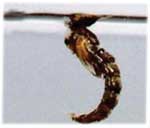The Beaded Pheasant Tail Nymph Fly
There are times when you need to fish deep because that is where the trout are feeding. The addition of a gold bead head to the classic Pheasant Tail Nymph fly pattern makes it one of the first flies you should consider.

PHEASANT TAIL FLY PATTERNS. Hook size 12 14 16 18 - $US each
The Beaded Pheasant Tail Nymph Fly's stream line body gives it good sinking qualities. It is an ideal point fly on a standard three fly lake and reservoir open water flyfishing rig. The bulge just behind the gold bead head imitates the wing casing on the natural invertebrate insects that trout feed upon. In shallower rivers and streams you can use the Gold Bead Head Pheasant Tail Nymph to imitate the action of a crawling bottom dwelling insect floating with the current looking for its next meal or place to shelter. Use short retrieves followed by a longer pause to allow the bead head to work and sink your Pheasant Tail Nymph onto the river or stream bed.

LOOKING AFTER YOUR LOCAL TROUT STREAM AND RIVER
What are the factors that affect the amount of adult trout you find in your local river or stream? Trout and other freshwater fish lay a lot of eggs to cope with the expected high mortality of the young hatchlings. Research has shown that more than 90% of young trout that hatch will perish. A large majority will die from being eaten by larger predatory adults fish. A two pound female trout will typically lay about 1500 eggs. The change in mortality rate from 92% to say 97% can have a huge impact on the amount of adult fish you see swimming in your favorite rivers, lakes or streams.
An important condition for the growth of a baby trout to a mature adult fish is the availability of good habitat. The presence of course woody debris along the edges of the stream is very helpful as it provides cover. This is known as "brash". A critical time for a young trout is when it emerges as a fry from the spawning gravels. As it starts to feed for itself, just before they all disperse, they are easy prey. They need to have nearby shelter. Ideal water height should be between 30 cm to 10 cm deep with a low water velocity of between 30 cm to 0 cm per second. You can judge the health of the River if you can spot clean gravel mounds easily situated between swathes of green reedbeds. Many River keepers plant beds of tall flag iris plants nearby. The plants and reedbeds provide cover for the emerging fry.
Trout fry have the egg yolk sac still attached to the body. When it has been fully absorbed and up to one year old, these baby fish are called Parr. They prefer slightly deeper water of up to 60 cm with a high velocity water up to 50 cm per second. Most fish when they reach one-year-old are capable of reproduction and therefore termed adults. To survive they need much deeper water generally over 30 cm deep with a higher velocity of up to 60 cm per second.
A neat looking stream or river bank is not helpful to your fish who all want to stay alive to become adults. It might look nice to human visitors, but without shelter young trout are soon predated upon. Many fishing clubs hold off-season working parties to maintain the state of their section of river stream. By all means remove rubbish like old tyres and supermarkets trolleys, but think twice before removing overhanging vegetation, tree roots and aquatic plants. You may seriously damage the stock levels of fish that will be available when the new fishing season starts. Your fishing club should have a strategy on how to help trout Fry and Parr survive by providing additional shelter.
One way that is very pleasing on the eye is the planting of flag iris. They can also help prevent young fish being washed downstream to early, following heavy rains and a raging spate. The stems of the plants provide sanctuary from the high water velocity that occurs during these times. They work better than placed rock or gabion reinforcements. Rather than slowing down the water and creating protected zones, these bounce the fast flowing water away into the center of the water flow and more damagingly towards the river or stream bank where it causes unwanted erosion.
You need to get the correct ratio of dense brash protective cover next to your stream's trout spawning habitat area. This is the most effective way to get the best conversion of hatched fry to adult trout. Another area of concern should be weather there is enough protection for trout waiting out the cold winter months in the slower pools. Do they have enough cover? Another advantage using natural vegetation to provide protective cover for trout is that it also provides a good habitat to the invertebrates that makes up most of the trout's diet.
LINKEDIN READER'S COMMENT
What type of Pheasant Tail Nymph do you prefer? - Most of mine are pretty standard. Some beadhead, some not. Sometimes, just for fun I'll mix up colors. Doesn't seem to make much of a difference. - By Ken Hume


Fly Fishing books

